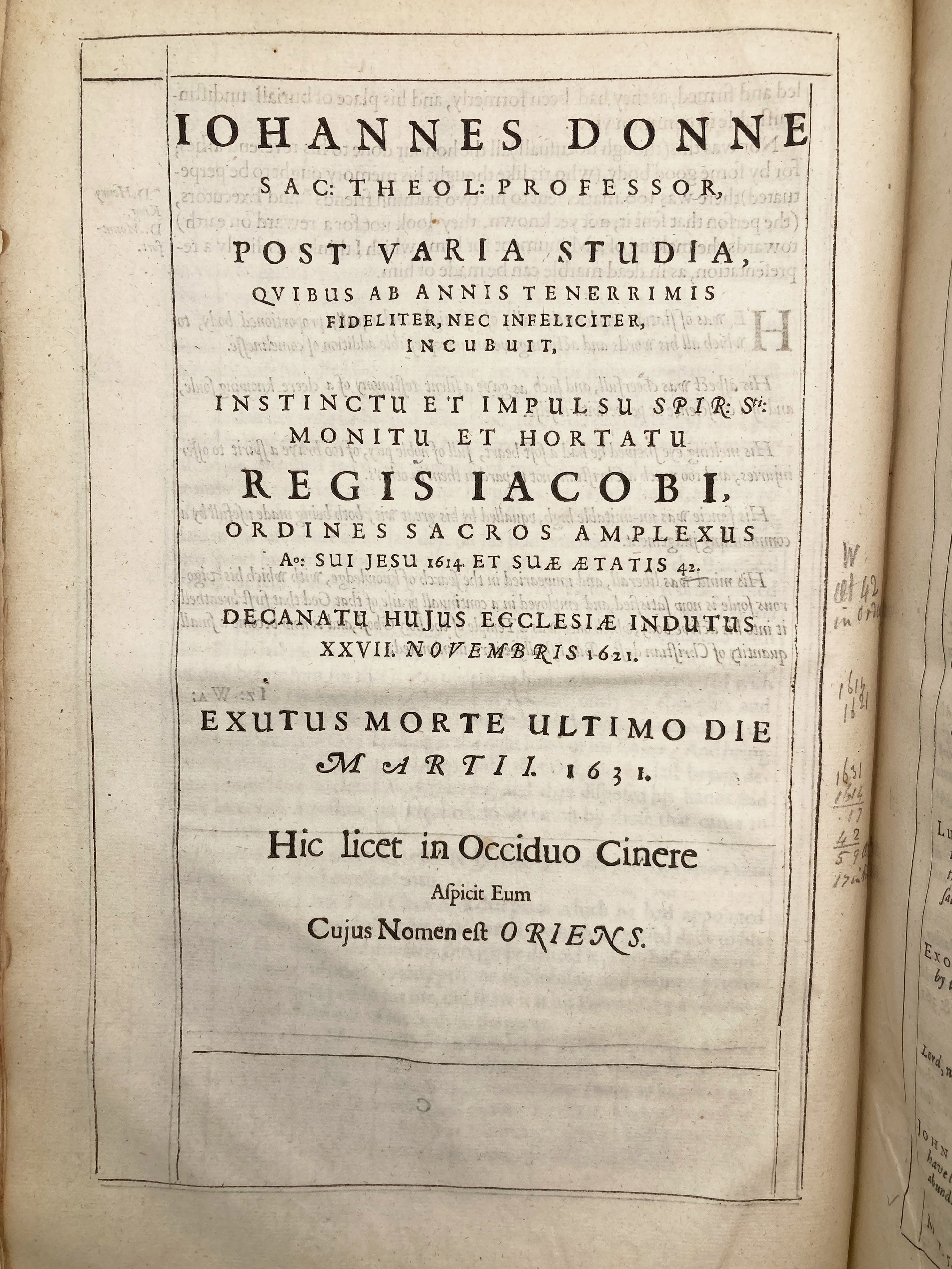DONNE, John.
LXXX sermons
London: Printed for Richard Royston … and Richard Marriot, 1640£3,750.00
FIRST EDITION. Folio. pp. [xxxiv], 1-826, [xxii]. Roman, some Italic. Text ruled throughout, woodcut printer’s device to title (McKerrow 308), engraved frontispiece portrait of Donne aged 42 by Matthaus Merian the Younger (1621-1687) after Isaac Oliver’s (1556-1617) miniature within fine architectural border, woodcut initials and ornaments. A very good copy in full contemporary calf, both covers ruled with double fillet border, spine in seven compartments, repaired at head and tail, blind-tooled double-ruled border to each, ink lettering to first compartment, red blind-stamped book-label to second, remnants of metal clasps. Complete, with initial and terminal blanks. Pages 73, 201, 578, 579, 622, 642, and 653 misnumbered, bookplate of Christopher Clark Geest on front pastedown, 20th-century marginalia in pencil to a few gatherings, fore-edge of gathering ‘C’ somewhat frayed.
First edition of this important collection of Donne’s sermons edited and issued by his son and literary executor, John Donne the younger (1604 – 1662/3). LXXX Sermons hugely expanded the number of Donne’s sermons available to contemporary readers from the thirteen that had been published either during his life or just after his death to the eighty contained in this imposing folio volume.
John Donne (1572–1631) was ordained deacon and priest on 23 January 1615 at the instigation of King James. Soon after his ordination he was appointed to a royal chaplaincy and in November 1621 he was elected and installed as Dean of St Paul’s. “Donne left his sermons to Henry King, and they later, by a rather murky process, went via Walton to John Donne the younger, who published those in his possession in three folio volumes’ – of which LXXX Sermons (1640) is the first (ODNB).
Donne’s ecclesiastical career occurred during what has been called the ‘heyday of preaching’ in England (McCullough, chapter 3). A keen sermon enthusiast, James I expanded the number of sermons held at court to twice weekly (in addition to Sundays, a weekly Tuesday sermon was established to commemorate James’s escape from the Gowry conspiracy) and patronised preachers, including Donne, extensively. Many of the sermons contained in this collection were indeed read in front of James I at one of his royal residences; many others, however, were preached by Donne at a different pulpit, such as that of St. Paul’s Cross or Lincoln’s Inn. The place in which a sermon was given had an influence on its style and content which was nearly as strong as that of the liturgical day it marked. For instance, the sermons which Donne read at the outdoor pulpit of Paul’s Cross tended to be more political in nature, frequently marking anniversaries such as Accession Sunday and the Gunpowder Plot – while those given at Lincoln’s Inn, where Donne had lodged as a student in 1592, were more likely to feature legal terminology familiar to members.
The sermons in the collection are arranged in liturgical order; the group of seven sermons ‘on the Nativitie’ is followed by a collection of five sermons preached on Candlemas day – these are in turn followed by the Lenten sermons, and so on through Easter-day and until All-Saints’ Day. Once the liturgical calendar has been exhausted, additional sermons are grouped according to biblical text or theme (‘On St. Paul’s Conversion’, ‘On the Penitentiall Psalms’, Prebend Sermons), and finally by location. Donne’s sermons would have been delivered entirely from memory, for Jacobean and Caroline ‘auditories took a dim view of any preacher who addressed them from notes, much less read out a prepared text’ (McCullough, 2012). The holographs, which are the copy-texts of the printed sermons in this edition, would have been prepared by Donne either before or soon after his delivery.
“The posthumous LXXX Sermons of Donne (1640) […] bears comparison with the First Folio of Shakespeare as a work of pietas, as an attempt at ‘canonization’ of the author, and as a printed artefact” (Findlay). This canonizing impulse is at work in the short piece by Izaak Walton entitled ‘The Life and Death of Dr Donne’ which appears for the first time in the prefatory material of this collection, and in which the emotional power and rhetorical skill which made Donne a celebrated preacher is movingly extolled. “A Preacher in earnest, weeping sometimes for his Auditory, sometimes with them, alwayes preaching to himselfe, like an Angel from a cloud, though in none: carrying some (as S. Paul was) to heaven, in holy raptures; enticing others, by a sacred art and courtship, to amend their lives; and all this with a most particular grace, and un-imitable fashion of speaking.” (B2r)
STC 7038; Keynes 29; Hind III, p. 330, 4; not in Pforzheimer. Colclough, David. \\\\\\\\\\\\\\\"Donne, John (1572–1631), poet and Church of England clergyman.\\\\\\\\\\\\\\\" Oxford Dictionary of National Biography (2011). McKerrow, R. B., Printer\\\\\\\\\\\\\\\'s & Publishers\\\\\\\\\\\\\\\' Devices in England & Scotland, 1485-1640 (1912). McCullough, Peter E,. Sermons at Court: Politics and Religion in Elizabethan and Jacobean Preaching (1998). Brian Findlay, “Sermon”, in The Oxford Companion to the Book (2010). Peter McCullough, ‘Donne as Preacher’, in The Oxford Handbook of the Early Modern Sermon (2012).In stock








